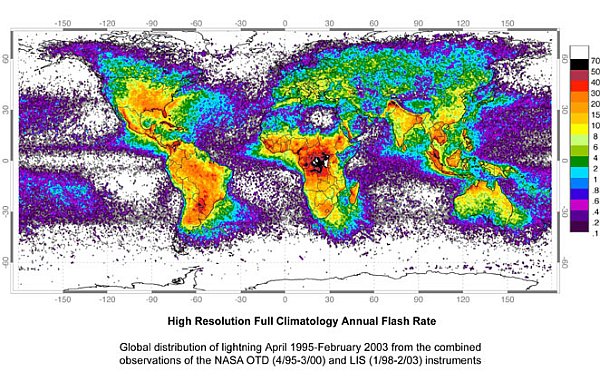NASA satellites have uncovered fascinating things about our world. One of them is shown on the spinning colored globe above.
This 15-second video is a composite map of lightning flashes observed by NASA OTD and LIS instruments from April 1995 through February 2003. Places with virtually no lightning are white, low levels are purple, then increasing amounts pass through the colors of the rainbow finally to red, black and white again.
Let’s slow it down and look more closely. Here’s NASA’s static map of the same thing showing the distribution of lightning per square kilometer per year.

It’s interesting to note the hot and cold spots:
- Lightning is far less frequent over water than land.
- It virtually never occurs at the poles.
- Winter is a great lightning suppressor. I can count on one hand the number of times I’ve seen lightning while it’s snowing. Those times were quite memorable.
- The worst place for lightning in the U.S. is Florida.
- Be careful in Singapore, northern Columbia, and Kashmir.
- There’s so much lightning in equatorial Africa that the map-maker ran out of colors!
Clearly it’s unsafe to play outdoors in the DR Congo. It’s hard to imagine how people cope with it there.
(lightning map from Goddard Space Center lightning study, 2003. Spinning globe created from NASA lightning map and posted on YouTube by “scienceonasphere.”)
p.s. We had some sneaky lightning yesterday afternoon. A downpour, then the rain stopped and while everything was dripping… BAM! It sounded like an explosion. I’m glad I was indoors.
Not only that, but the lightning streaked back from the storm cloud moving to the east to cut west back across blue skies. I got to see more than one lightning bolt into the blue, too (really fast since it was so close), looking out my window across Fifth Ave & up DeSoto St. Very cool.
I wondered what it looked like! Thanks